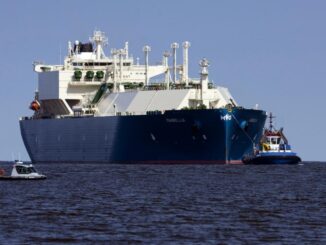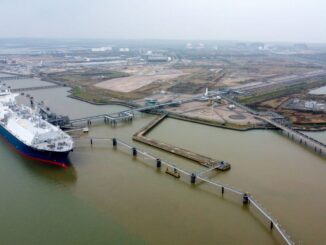
The EU pledged to become climate neutral by 2050. In July 2022, the European Commission passed legislation to accelerate decarbonization that labels gas and nuclear energy “as environmentally sustainable”. The Commission says private investments are needed in gas and nuclear as “transitional activities contributing to climate change mitigation.”
Pascal Canfin, chair of the European Parliament’s committee on the environment, explains: “Our main and most urgent priority is to phase out coal, as soon as possible in Europe… If you replace a coal power plant emitting around 1,000gCO2/kWh with a gas plant, you massively reduce your emissions”.
Eliminating the use of high-pollutant fossil fuels such as coal and heavy fuel oil is vital to reaching climate goals. Unfortunately, renewable energy technology is currently far from meeting global needs for electricity and transportation.
And with Russian gas now off-limits, companies are busy securing other locations for liquified natural gas (LNG) production as today’s less pollutant and more reliable source of energy. They are also investing in innovations for natural gas technology.
The Great Gas Debate
The Commission’s decision drew criticism from staunch environmentalists. They believe that because gas burns only 50% cleaner than coal, it is greenwashing to call it “sustainable”.
There is no question that gas is not climate-neutral. It produces some CO2 and methane leaks can occur when extracting and transporting gas.
But gas is still cleaner than other dependable energy sources. It emits no Sulphur Oxide or Particulate Matter and much less Nitrogen oxide and CO2 than other fossil fuels. The province of Alberta, Canada reduced its greenhouse gas emissions from electricity by 40 million tonnes in less than a decade by converting coal-fired power plants to gas.
Ecologists respond that investments should prioritize carbon-neutral energy. But current technology for renewable energies has not advanced enough to be able to power the world’s electricity and transportation needs in the foreseeable future.
Take wind farms, for example. On and offshore wind farms have been popping up all over Europe. In 2021, winds were not as high as usual so windmills produced less electricity. Germany, Britain, and Denmark are typically Europe’s largest wind producers but instead had to scramble for alternative power.
Indeed, others commended the Commission’s vote for recognizing gas as critical for decarbonization. David Blackmon, an energy public policy analyst, says the vote “reflects a growing recognition that the ongoing ‘energy transition’ is going to be far more complex and difficult to achieve than the overarching, simplistic narratives”.
Innovations Around LNG
As a relatively new fossil fuel, innovations are in the early stages and will only help make gas production cleaner. For the LNG industry to be low-carbon, innovations have mainly focused on the upstream on the value-chain, by reducing methane leaks and the energy required to transform natural gas to LNG when cooling it to -162℃. Some studies even consider that gains of up to 97% of current emissions can be expected, by using hydrogen to power the facilities.
American and Canadian start-ups are working on technologies to detect methane leaks at production sites quickly and cost-effectively using planes, drones, and satellites.
Innovations are also improving how gas is used downstream the value chain. Particularly for the transportation sector which was responsible for 24% of global CO2 emissions in 2018. These advances are welcome because renewable energies in transportation have also not been the panacea many hoped for.
For example, a study from the American Transportation Research Institute (ATRI) found that while zero-emission trucks (battery-electric and hydrogen fuel-cell electric trucks) do not release C02 emissions while running, making them produces almost 500,000 pounds of C02 emissions compared to 75,000 pounds for diesel trucks.
Here too, gas meets the need for a realistic, progressive transition, especially since improvements are constantly being made in reducing harmful emissions. Because of that, many have turned to LNG-run trucks which emit 20% to 30% less GHG and 95% less particulate matter than diesel.
These trucks can also use bioLNG or biomethane without any modifications. Supply for these alternative carbon-neutral (even carbon-negative) fuels is currently limited, but the potential is there and technology is advancing. Indeed, UPS announced plans to replace part of its fleet with 6,000 renewable natural gas-powered trucks as part of its efforts to have a carbon-neutral fleet by 2025.
The global shipping industry is also using LNG innovations to reduce its carbon footprint. An independent study found that using LNG instead of oil-based fuels would reduce GHG by 23%. And technological advances for LNG-fueled ship engines are increasing benefits. The Nautilus project started work in 2020 on a new type of LNG-based engine with a solid oxide fuel cell that can turn LNG into electricity by powering a battery without burning gas. Together, the battery and fuel cell propel the ship, producing 50% less GHG emissions than diesel.
Promising LNG Investments
Companies are investing in LNG production across the globe to meet increased demands for this transitional energy source. Many are also trying to limit the environmental impact of projects and further reduce the lifecycle GHG emissions of LNG.
Canada, with its strict flaring and venting regulations, is close to completing its first LNG export project. The LNG Canada project, led by Shell Canada (40%) and Malaysia’s Petronas (25%), should produce 14 million tonnes of LNG per year as of 2025. A second phase using hydroelectricity for the liquefication process is under consideration. Because Canada’s very low average temperatures mean less energy is needed for liquefication, a 2018 Delphi Group study found that the project has one of the world’s lowest GHG emissions per tonne of LNG produced.
Another promising venture is The Mozambique LNG Project led by TotalEnergies with a 26.5% stake. It sits on 65 trillion cubic feet of natural gas and a two-train liquefication plant could produce up to 43 million tonnes per annum. Gas from the project’s location has almost no carbon dioxide to begin with. Additionally, methane leaks are expected to be below 0.2% because production is concentrated around ten to fifteen wells producing to one platform.
Max Tonela, Mozambique’s Minister of Mineral Resources and Energy said that: “Although we have a gas that already has a small emission content, we are prioritizing the use of pre-existing decarbonization technologies” and that gas from Mozambique would be key in deactivating coal-fired power plants in Africa.
“Alternatives are limited”
While the decision had its critics, given the data and today’s technology, the European Commission’s labeling of gas as “sustainable” and a “transitional activity” was a realistic, rational approach to addressing climate change.
Nitin Agarwala, research fellow at the Indian National Maritime Foundation, sums up the situation perfectly:
What emerges is that while there is merit in the controversy and the queries raised by the nay-sayers, the available alternatives are limited, and a delay in shifting to LNG as a fuel for decarbonizing, even if only for transition, may be detrimental for humanity since there is no certainty about the development of a net-zero emission fuel, it’s a delivery timeline and if it would be successful. This does not mean investments in renewable energies should be minimized. It just means LNG projects are also needed so we can continue reducing the use of coal and other high-pollutant fossil fuels right now. And innovations in LNG production and use are making significant strides in making this transitional energy cleaner.



